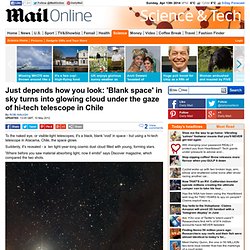

BLACK HOLES. PULSARS. QUASARS. GALAXIES. STARS. DIFFERENCE BETWEEN A GALAXY & A NEBULA. Sweet! Astronomers find sugar floating in space - proving that the building blocks of life can exist without a planet. Discovery of gas cloud of sugar circling a star shows that 'life-forming molecules' can form without a planetThe molecule, 'glycoaldehyde', exists within every single living cellStar is 'on our doorstep' - just 400 light-years away By Eddie Wrenn Published: 14:58 GMT, 30 August 2012 | Updated: 15:11 GMT, 30 August 2012 Astronomers observed a very young star located in the left part of image (yellow box) to discover 'sugar' in space Next time you make a sweet cup of tea, remind yourself how fundamental sugar is to life on this planet.

And that humble sweetener has played an even greater role in humanity's quest for knowledge this week, after astronomers announced that 'sugar' has been found floating freely in space. The simple molecules were spotted floating in the gas cloud around a star around 400 light-years away. Naturally, this is not the granular sugar that you find in white packets in supermarkets, but organic carbohydrates molecules, made of carbon, hydrogen, and oxygen. Nasa's Hubble Space Telescope spots planet shedding atmosphere following solar flare. By Eddie Wrenn Published: 12:41 GMT, 29 June 2012 | Updated: 13:58 GMT, 29 June 2012 Astronomers the Hubble Space Telescope have seen dramatic changes in the upper atmosphere of a faraway planet.

Just after a violent flare on its parent star bathed it in intense X-ray radiation, the planet's atmosphere gave off a powerful burst of evaporation. The observations give a tantalising glimpse of the changing climates and weather on planets outside our Solar System. Astronomer Alain Lecavelier des Etangs and his team used Hubble to observe the atmosphere of exoplanet HD 189733b during two periods in early 2010 and late 2011, as it was silhouetted against its parent star. While backlit in this way, the planet's atmosphere imprints its chemical signature on the starlight, allowing astronomers to decode what is happening on scales that are too tiny to image directly.
Scroll down for video: Bright spark: In this ESA simulation, the sun flares up as planet HD 189733b transits past See video here: Just depends how you look: 'Blank space' in sky turns into glowing cloud under the gaze of hi-tech telescope in Chile. By Rob Waugh Updated: 13:05 GMT, 10 May 2012 To the naked eye, or visible-light telescopes, it's a black, blank 'void' in space - but using a hi-tech telescope in Atacama, Chile, the space glows Suddenly, it's revealed - a ten light-year-long cosmic dust cloud filled with young, forming stars. 'Where before you saw material absorbing light, now it emits!

' says Discover magazine, which compared the two shots. Now you don't see it: To the naked eye, and visible-light telescopes, the cloud is black, a 'blank' in space Revealed! Hubble Update 22 {21st of July 2011}: Four Unusual Views of the Andromeda Galaxy (Narrated)